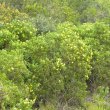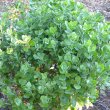| Botanical Name |
Chrysanthemoides monilifera |
| Family |
Asteraceae - The daisy family. |
| Pronunciation |
kris-an-theh-MOY-deez mon-ee-LIF-er-a |
| Common Name(s) |
Afrikaans: Bietou; Bosluisbessie
IsiXhosa: ulwamfithi; ilamfithi
IsiZulu: inkupheyana; itholonja
Sesotho: Motlempe; Ntloyalekxwaba
|
| Plant Group |
- Shrub A woody plant of relatively low height, having several stems arising from the base and lacking a single trunk; a bush.
|
| Plant Size |
- Medium to Large
| Tree | 15m to 20m |
| Shrub | 2m to 3m |
| Perennial/ground cover | 60cm to 75cm |
| Bulb | 60cm to 1m |
| Succulent | 60cm to 1m |
|
| Position |
- Partial Shade The area is in shade for part of the day and in full sun for part of the day.
- Sun The area is in full sun for all or most of the day, all year round.
|
| General Information |
- Drought Tolerance: High The plant is well adapted to arid conditions; it can survive long periods of drought and high temperatures without extra water.
- Evergreen Plants that have leaves all year round.
- Frost: Hardy The plant can withstand freezing temperatures or frost without artificial protection.
- Salt spray tolerant A plant with specific adaptations enabling it to grow in a saline environment.
- Sand tolerant Plants adapted to survive in nutrient poor, very sandy soils.
- Water Wise Plant species originating from low rainfall regions that require less water to survive and thrive than other plant species.
- Wind Tolerant Plants able to withstand the effect of strong winds.
|
| Specific Information |
Chrysanthemoides monilifera is a fast growing, semi-succulent shrub with fleshy, green to grey-green leaves. The young leaves are densley covered with web-like hairs. Young stems are succulent but become woody with age. The blackish to purple oval fruits are edible and sweet. The shrub has a life span 8-12 years, making it an ideal pioneer species for new gardens.
Chrysanthemoides monilifera has become an invasive weed in Australia, covering thousands of hectares of coastal and natural reserve areas.
|
| Ad Break |
|
| Flowers |
| Description |
daisy to 40 mm in diameter.
|
| Season |
- All Year Plants will seldom bloom for the entire season as given in the list, but should flower during a period within these parameters.
- Autumn to Winter Plants will seldom bloom for the entire season as given in the list, but should flower during a period within these parameters.
|
| Colour |
|
| Growth Rate |
- Very Fast Specifying growth rate can be very misleading as there is considerable variation of growth rate depending on type and species of plant, available water, supplementary feeding, mulching and general care, as well as the plants suitability and adaptability to the garden environment.
|
| Plant Uses |
- Attracts bees, butterflies or other insects This plant attracts insects which can be food for birds or other creatures in your garden.
- Attracts Birds This plant will attract birds.
- Border A strip of ground, at the edge of a driveway or path in which ornamental plants or shrubs are planted.
- Boundary A plant useful for planting around the edges of the property to form a green or colourful backdrop, an impenetrable hedge, to hide walls or create privacy.
- Filler Either a fast growing tree or shrub used temporarily to fill in an area while the permanent plants grow to a desired size, or a plant used to fill gaps in borders or beds.
- Hedge Suitable trees or shrubs planted relatively close together so that the branches intertwine to create a barrier. This can be formal – the plants are regularly trimmed to produce a neat shape, or informal – the plants are left to themselves to create a natural hedgerow.
- Pioneer for new gardens A very fast growing plant, able to withstand hardship, that can be used to populate land that has recently been cleared of natural vegetation. These plants pave the way for slower-growing species by adding nutrients to the soil and creating leaf litter.
- Screen A tall hedge of suitable plants planted closely together and used as a windbreak, to block a bad view, to separate parts of the garden or as a backdrop.
- Suitable for coastal gardens Plants adapted to dry, sandy soil, forceful wind, limited rainfall and intense sunlight.
- Suitable for seaside gardens Plants that will survive the hostile environment of harsh salty winds, dry sandy soil, irregular rainfall and heat found in seaside gardens.
- Wild Garden An indigenous garden planted for the benefit of wildlife and birds. Provides food, water, a variety of mini-biomes and no poisonous chemicals are used.
- Windbreak Trees planted in a row to form protection from prevailing winds by breaking the force of the wind, thereby reducing wind damage.
|
| Distribution and Habitat |
in the Northern, Western and Eastern Cape Provinces, along the Drakensberg escarpment in KwaZulu-Natal, Swaziland and Mpumalanga, and further into the Chimanimani Mountains of eastern Zimbabwe and to northern eastern Africa, in fynbos, strandveld, grassland, subtropical coast, margins of forests and in grassland vegetation
|
| Planting Suggestions |
Plant in a well-drained position with sufficient space to grow. Apply compost annually during winter or spring to enhance growth and performance. Mulch well to retain moisture. Cut back in late winter after the main flowering period to retain a dense bushy appearance.
|
| Medicinal Uses |
Khoi and San used the fruit as a food source. An infusion of the leaves is used as an enema to treat fevers.
|
| Ad Break |
|







Discuss this plant
Share knowledge, ask a question or give an experience.